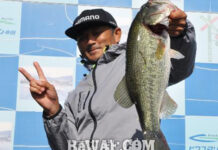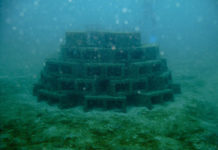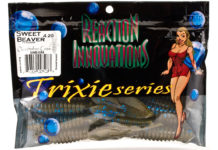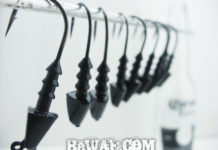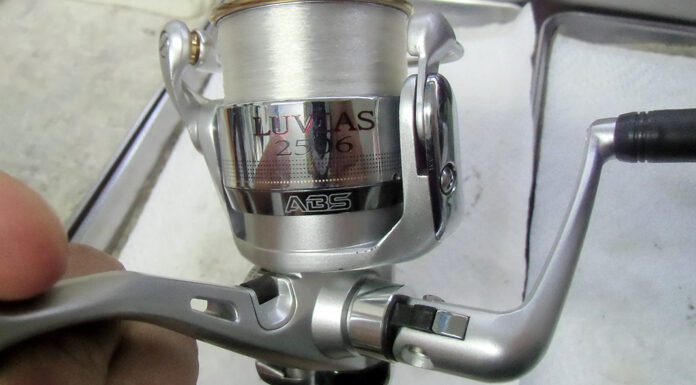 一昔前まではディープクランクキングなんて言葉は存在していなかった。当時から Norman DD-22, Poes 400, Mann’s 20+ 等がリリースされていたが、世間ではこれらのクランクベイトはトローリング用として認識されていた。ことの流れが変わったのはレーベル社のアルファベットシリーズのクランクベイトの発売「The Rebel Maxi-R」が登場してからだ。
一昔前まではディープクランクキングなんて言葉は存在していなかった。当時から Norman DD-22, Poes 400, Mann’s 20+ 等がリリースされていたが、世間ではこれらのクランクベイトはトローリング用として認識されていた。ことの流れが変わったのはレーベル社のアルファベットシリーズのクランクベイトの発売「The Rebel Maxi-R」が登場してからだ。
元祖ディープクランク昔話
 このオリジナルの Maxi-R は実は大きなスクエアビルクランクベイトだった。75ミリのビックボディに24グラムの重さが特徴なビックダディだった。そして後にダイビングリップにチューンされたモノが「the Deep Maxi-R」になった。そしてさらに改良されたのが「the Double Deep Maxi-R」大きなボールシステムが組み込まれたビルが急潜行を可能にし、大きな浮力体が障害物にブツかっても動く自然な姿勢を保ち続けさせた。このクランクベイトがディープストラクチャーやクリークチャンネルを攻めるトップトーナメンターに絶大に指示されるようになった。
このオリジナルの Maxi-R は実は大きなスクエアビルクランクベイトだった。75ミリのビックボディに24グラムの重さが特徴なビックダディだった。そして後にダイビングリップにチューンされたモノが「the Deep Maxi-R」になった。そしてさらに改良されたのが「the Double Deep Maxi-R」大きなボールシステムが組み込まれたビルが急潜行を可能にし、大きな浮力体が障害物にブツかっても動く自然な姿勢を保ち続けさせた。このクランクベイトがディープストラクチャーやクリークチャンネルを攻めるトップトーナメンターに絶大に指示されるようになった。
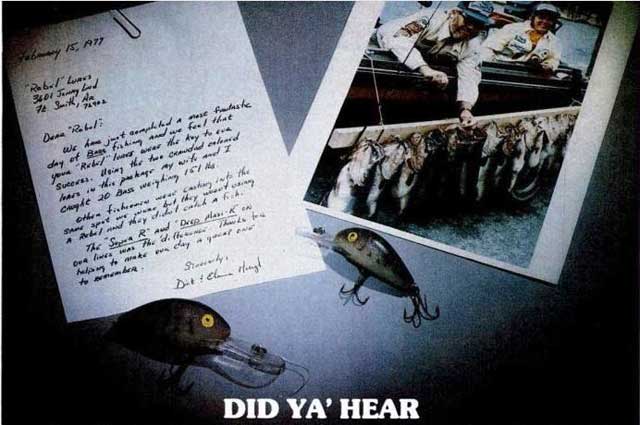 これらのルアーが流行するにつれてタックルの進化も問われるようになった。これらのクランクベイトは3.6メートルラインから釣果を発揮するルアーなのでロッドはヘビーアクションが最低条件。リールはローギアの3.8:1 や 4.2:1 が必要となった。また各ローカルトーナメントでのハイウェイト記録がこれらのディープクランキングパターンとなり定番となった。*写真は1977年の広告 “DID YA’ HEAR” アラバマ訛り調で “このルアーを知っとるかい?”
これらのルアーが流行するにつれてタックルの進化も問われるようになった。これらのクランクベイトは3.6メートルラインから釣果を発揮するルアーなのでロッドはヘビーアクションが最低条件。リールはローギアの3.8:1 や 4.2:1 が必要となった。また各ローカルトーナメントでのハイウェイト記録がこれらのディープクランキングパターンとなり定番となった。*写真は1977年の広告 “DID YA’ HEAR” アラバマ訛り調で “このルアーを知っとるかい?”
また the Maxi-R は沢山の定番カラーも定着させた。代表的なカラーには Bone/Orange Belly や The Old Brown Crawdad が有名である。アラバマ方面では本当に良く釣れるカラーで愛され続けた。今日でもバスプロ達が使い続けるスタンダードなカラーとなっている。
今日のディープクランク市場では the Bagley Diving B (DB-III) や Mann’s 20+ が未だに売れ続けているが the Maxi-R の存在があってこそのディープクランクな世界が開けた事はいうまででもないだろう。
*記事や時系列に間違いがあるかも知れません。
Once upon a time there was no such thing as a Norman DD-22, a Poes 400 or a Mann’s 20+. There were Bombers (the old metal square bills), Mudbugs and Hellbenders. That was pretty much it in the world of deep cranking, and even those were almost as synonymous with trolling as with casting. Much of that changed though with some of the early deep diving “alphabet” plugs made by Rebel, and the “big daddy” of them all, the Rebel Maxi-R.
The original Maxi-R was actually a large square bill crankbait. At 3″ and nearly 7/8oz., it was a mouthful for the time. Rebel would later go on and put a large diving bill on many of their models, and the Deep Maxi-R was born. An even later version was the Double Deep Maxi-R, which featured a large ball bearing molded into the lip of the bait to help achieve a steeper diving angle and some extra weighting, this all at a time long before neutrally buoyant baits. These deep diving Maxi’s became the work horses of early deep crankbaiters and “structure” fishermen, and many bass tournaments were won fishing “deep” ledges, points and creek channels with these baits.
Even though they were large in size, they still only tended to run about 12′ deep. Typical equipment was a heavy action rod and a very low gear ratio reel, something in the 3.8:1 to 4.2:1 range. Even then, some likened fishing the Deep Maxi-R to dragging a bowling ball through the lake, and any angler that put in a full day’s cranking would certainly be feeling it the next day. This bait would flat wear you out…but it also flat caught fish – big sacks of them.
As just one example, this 1977 ad for the Maxi-R and it’s only slightly smaller cousin, the Super-R, revealed a letter and picture sent to the company of a 20 bass stringer of bass going 151 pounds. Go ahead and do the math, and you’ll see that works out to a better than 7-1/2 pound average per fish! As another example, Butch Tucker, father of Elite Series pro J Todd Tucker, once wrote that the Maxi-R was the bait that Steve Kennedy’s dad used to use to whoop up on everyone down in Alabama tournaments back in the early 80s.
The old color patterns on these lures wasn’t anything special, but it seemed like there were definitely favorites, one of those being bone/orange belly. That was a popular color in my neck of the woods too, with some of the local B.A.S.S. pros like Dusty Pine using the Maxi-R to win local state Federation events. The old brown crawdad pattern was another of the favorites, with chrome blue back, old school baby bass and sometimes black/chartreuse filling in the remainder of most tackle boxes.
Eventually, this bait fell out of favor when the Bagley Diving B (DB-III) and Mann’s 20+ hit the scene, but ask any old deep cranker and they’ll likely admit to the Maxi-R and it’s similar deep diving Rebel counterparts as having a special place in their hearts.


